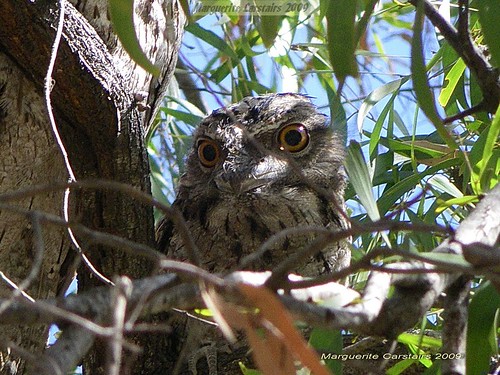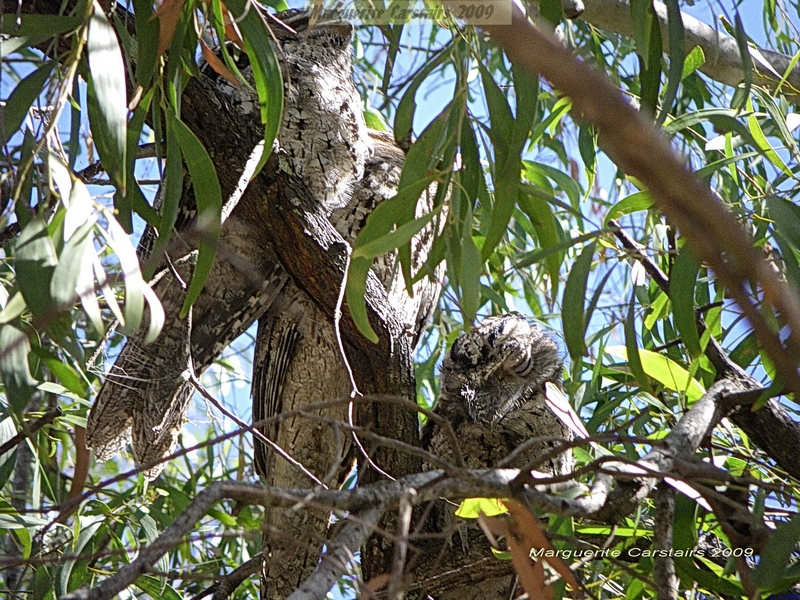I thought it was an owl, and just discovered it is a Frogmouth.
They are still there in the same tree and growing bigger.
One always seems to be awake each time I visit.
They are birds that are awake at night.
They are not owls.
They eat insects, frogs and small animals.
Their covering is feathers.
They hide by staying still looking like a tree branch.
The Tawny Frogmouth is often thought to be an owl, but is in fact related to nightjars. There are 14 species, or kinds, or frogmouth.
Habitat and Distribution (where they are found)
 Frogmouths are commonly seen throughout Australia, but not in rain forests or deserts. Tawny frogmouths prefer open eucalyptus woodland.
Frogmouths are commonly seen throughout Australia, but not in rain forests or deserts. Tawny frogmouths prefer open eucalyptus woodland.Appearance and Behaviors
Frogmouths do not have strong talons (claws) like owls.
Males and females look alike, and are 35-50 cm long.They have yellow eyes and a wide beak topped with a tuft of bristly feathers. They make loud clacking sounds with their beaks and their call sounds like drumbeats.
Photograph by Mike Dyson, with permission
Owls fly around at night hunting food, but Tawny Frogmouths generally remain sitting very still on a low perch, and wait for food to come to them. They catch prey with their beaks, and sometimes drop from their perch onto the prey on the ground.
 Tawny frogmouths hunt at night and spend the day roosting on a dead log or tree branch close to the tree trunk.
Tawny frogmouths hunt at night and spend the day roosting on a dead log or tree branch close to the tree trunk. Their camouflage is excellent - staying very still and upright, they look just like part of the branch.
Diet
The Tawny frogmouth feeds on rats, mice, cicadas, beetles, frogs and other small prey. They catch their prey with their beaks rather than with their talons, another way in which they are different from owls.
Life Cycle
 Tawny frogmouth pairs stay together until one of the pair dies. They breed from August to December. They usually use the same nest each year, and must make repairs to their loose, untidy platforms of sticks. After mating with the male, the female lays two or three eggs onto a lining of green leaves in the nest. Both male and female take turns sitting on the eggs to incubate them until they hatch about 30 days later. Both parents help feed the chicks.The chicks move to the edge of the nest and direct their droppings over the edge. About 25 days after hatching, the chicks are ready to leave the nest and lead their own lives.
Tawny frogmouth pairs stay together until one of the pair dies. They breed from August to December. They usually use the same nest each year, and must make repairs to their loose, untidy platforms of sticks. After mating with the male, the female lays two or three eggs onto a lining of green leaves in the nest. Both male and female take turns sitting on the eggs to incubate them until they hatch about 30 days later. Both parents help feed the chicks.The chicks move to the edge of the nest and direct their droppings over the edge. About 25 days after hatching, the chicks are ready to leave the nest and lead their own lives.http://www.amonline.net.au/factsheets/tawny_frogmouth.htm
Sydenham, S. & Thomas, R. Tawny Frogmouth [Online] www.kidcyber.com.au (2003)


140x45.jpg)




No comments:
Post a Comment